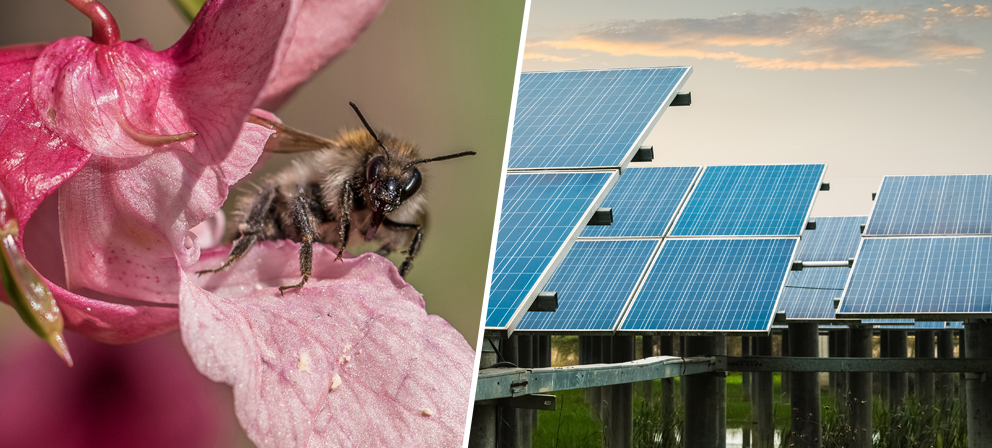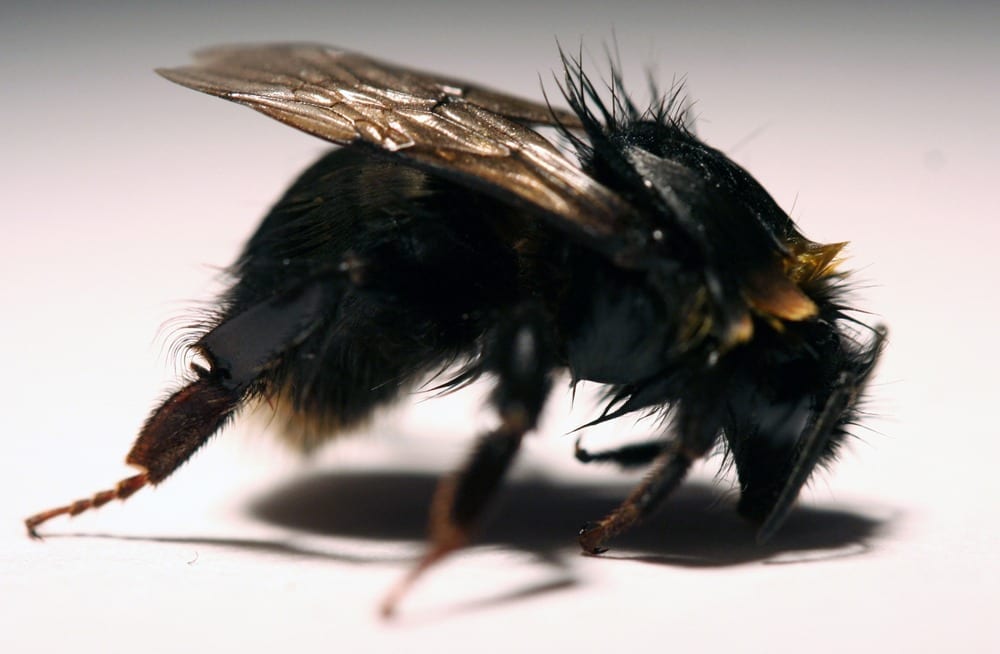
Managing solar parks for honeybees can have positive impacts on crop yields and thus financial returns. But, it is important to consider the suitability on a site by site basis given the potential implications for wild pollinators and the benefits of managing sites for biodiversity more broadly.
Dr Alona Armstrong
The value of UK agriculture could be boosted by millions of pounds a year if thousands of honeybee hives were deployed on solar parks across the country, a new study reveals.
However, scientists caution that the benefits of managing solar parks for wild pollinators over honeybees should be prioritised where appropriate and should be assessed on a site by site basis.
A team of researchers from Lancaster University and the University of Reading has for the first time quantified the potential economic benefits and costs of installing honeybee hives on solar parks across the UK.
Solar parks are playing an increasingly important role in our national shift towards carbon zero as their contribution to electricity generation rises.
However, solar parks take up a lot of land, and as more parks are created to meet clean energy demand the it is important to look at how they can be used to bring about other environmental or commercial benefits.
One opportunity is to install honeybee hives on solar parks. A lot of solar parks are located in areas of intensive agriculture where many wild pollinator habitats have been lost or degraded. Honeybee hives provide ready-made armies providing a pollinating service to increase crop production in surrounding farmland. Although some honeybee hives have been used on solar parks, the potential economic benefits of this were, until now, unknown.
The research team used detailed land cover maps, such as those produced by the Centre of Ecology and Hydrology, to understand where solar parks are located, as well as crop distribution and rotations, existing data on honeybee hives, crop pollination requirements and crop values.
They also factored in the cost of installing and managing the honeybee hives on the solar parks.
Using crop distribution patterns in 2017, the researchers found that deploying honeybees on solar parks could have raised the value of crop yields that year by £5.9 million.
The study looked at field crops such as field beans, linseed and oilseed, top fruits such as apples and pears including varieties to make cider and perry, as well as soft fruits such as strawberries, raspberries and blackcurrants.
The findings showed that in England the crop that would potentially benefit the greatest from installing honeybee hives is oilseed, because it is so widely cultivated. Though soft fruits, and especially strawberries, would see the greatest economic benefit per land area given their high market value and relatively high dependency on honeybee pollination.
Based on 2017 data then honeybees on solar parks could boost field crop yields by £2.6 million, top fruits by £1.3 million, and soft fruit yields by £1.9 million.
There were also regional patterns in the findings with values being highest in the east and south of England because those are the areas where a greater proportion of oilseed and soft fruits are grown.
They also found that, if taken to the extreme of all UK crops being grown within a 1.5km honeybee foraging radius of solar parks around the UK, then this could boost the value of those crop yields by £80 million a year – but researchers recognise this scenario is unlikely to be possible given other factors.
Given these findings, if UK agriculture wanted to maximise the economic benefits of having honeybees on solar parks then soft fruit growing would need to be prioritised within honeybee foraging zones of 1.5km around solar parks.
However, the researchers are keen to point out that the suitability of placing honeybee hives on solar parks needs to be assessed for each location. This is because not all locations including their climate and soil types are suitable for all crops, and individual farmers have preferences about what and where they produce. Also, different crops vary in their pollination needs and so the research team’s results cannot be generalised across all crop types and varieties.
In addition, great care needs to be taken to ensure the honeybees would not be competing with already established wild pollinator species. The researchers also highlight that where possible encouraging wild pollinators would provide greater ecological benefits than installing honeybee hives.
Dr Alona Armstrong, Senior Lecturer at Lancaster University and lead author of the study, said: “Managing solar parks for honeybees can have positive impacts on crop yields and thus financial returns. But, it is important to consider the suitability on a site by site basis given the potential implications for wild pollinators and the benefits of managing sites for biodiversity more broadly.”
Professor Simon Potts from the University of Reading and co-author of the paper said: “Our study demonstrates how multi-disciplinary research can find novel land management practices which can simultaneously benefit energy producers, farmers, beekeepers and consumers.”
The researchers’ findings will help inform energy policy, future business cases for future solar parks, as well as informing sustainable investments and decisions about including honeybee hives into energy and land management.
The findings are outlined in the paper ‘Honeybee pollination benefits could inform solar park business cases, planning decisions and environmental sustainable targets’, which has been published by the journal Biological Conservation.
Original Article: Putting honeybee hives on solar parks could boost the value of UK agriculture
More from: Lancaster University | University of Reading
The Latest Updates from Bing News & Google News
Go deeper with Bing News on:
Solar parks for honeybees
- Parks for a Sustainable Future
Envision an organic community where local parks, playing fields, and greenways are managed without unnecessary toxic pesticides, children and pets are safe to run around on the grass, and bees and ...
- Solar Energy News
Scientists have achieved a 23.64 percent ... New Evidence Shows UK Solar Parks Can Provide for Bees and Butterflies Feb. 21, 2024 — A new study shows that UK solar parks, if managed correctly ...
- What This Spring’s Solar Eclipse Means for Your Zodiac Sign
Solar eclipse astrology A solar eclipse happens when, at just the right moment, the moon passes between the sun and earth, obscuring the view of the sun either totally or partially, from a small part ...
- Can Solar Farms Save the Bees?
There were twenty times more native bees present at the solar installations at the end of the four years. In 2024, these aren't new results, but they match the findings of other studies.
- Celebrating ‘ourHOME’ For Earth Month
For Earth Month, National Geographic and Disney+ have launched the ourHOME campaign to remind everyone of all of the wonders of the planet we call home.
Go deeper with Google Headlines on:
Solar parks for honeybees
[google_news title=”” keyword=”solar parks for honeybees” num_posts=”5″ blurb_length=”0″ show_thumb=”left”]
Go deeper with Bing News on:
Solar parks for wild pollinators
- Wild turkey populations declined in some areas of U.S.
In a 2021 study, eight out of 30 states surveyed reported that turkey populations declined from 2014 to 2019, with some of the sharpest decreases in Alabama, Arkansas, Georgia, Louisiana and Oklahoma.
- Ohio’s state parks, forests host 150K for solar eclipse
COLUMBUS – The (ODNR) was proud to host more than 150,000 people during the total solar eclipse which awed and amazed onlookers on Monday. “People from all around the ...
- Q&A: Where the wild bees are—and aren't—impacts food supply
and bumble bees—and other wild pollinators like moths, wasps, beetles, and flies are found everywhere: in parks and fields, near farms and forests. There are more than 800 species of just native ...
- Where the wild bees are—and aren’t—impacts food supply
sweat bees and bumble bees—and other wild pollinators like moths, wasps, beetles and flies, are found everywhere: in parks and fields, near farms and forests. There are more than 800 species of ...
- Texas State Parks open for April 8 total solar eclipse. Here’s how to make a reservation
Fort Worth, get your solar eclipse safety glasses ready ... To make it an easier process, Texas Parks and Wildlife Department suggest the following: Have vehicle information ready.
Go deeper with Google Headlines on:
Solar parks for wild pollinators
[google_news title=”” keyword=”solar parks for wild pollinators” num_posts=”5″ blurb_length=”0″ show_thumb=”left”]










